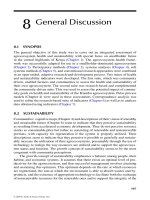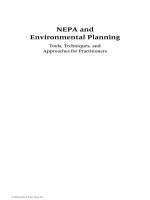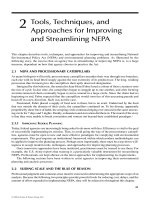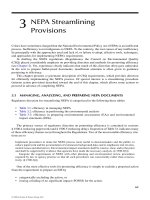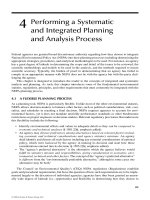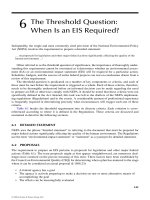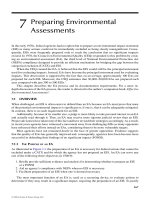NEPA and Environmental Planning : Tools, Techniques, and Approaches for Practitioners - Chapter 5 docx
Bạn đang xem bản rút gọn của tài liệu. Xem và tải ngay bản đầy đủ của tài liệu tại đây (271.71 KB, 15 trang )
129
5
Exemptions and
Categorical Exclusions
Actions, including categorical exclusions (CATXs), that are exempt from the requirements of the
National Environmental Policy Act (NEPA) are described in this chapter. This chapter begins with
a comprehensive description of the CATX process and is followed by a discussion on the types of
actions that are generally excluded from the requirements of NEPA.
5.1 CATEGORICAL EXCLUSIONS
CATXs, briey described in Chapter 2, were not fully dened. Because of their clear importance
to efciency, this section has been prepared to provide the reader with a thorough understanding of
the entire CATX process. A CATX is dened as
… a category of actions which do not individually or cumulatively have a signicant effect on the human
environment and which have been found to have no such effect in procedures adopted by a Federal agency
in implementation of these regulations (§ 1507.3) and for which, therefore, neither an environmental
assessment nor an environmental impact statement is required. An agency may decide in its procedures
or otherwise, to prepare environmental assessments for the reasons stated in § 1508.9 even though it is
not required to do so. Any procedures under this section shall provide for extraordinary circumstances
in which a normally excluded action may have a signicant environmental effect (§ 1508.4).
Since the impacts have already been determined to be nonsignicant, neither an environmental
assessment (EA) nor an environmental impact statement (EIS) is required to be prepared for those
actions qualifying for a CATX. Moreover, each agency is required to adopt implementing proce-
dures that include specic criteria for, and identication of, typical classes of action that
(ii) … normally do not require either an environmental impact statement or an environmental assess-
ment (categorical exclusions).
1
The Council on Environmental Quality (CEQ) recently published draft guidance on establish-
ing, revising, and using CATXs.
2
This guidance is intended to assist federal agencies in improving
and modernizing their administration of CATXs under NEPA. The draft guidance recommends
procedures and approaches for (1) establishing and revising CATXs; (2) involving the public;
(3) documenting development, revision, and use of CATXs; and (4) periodically reviewing CATXs.
Additional direction can be found in § 1500.4[p], § 1500.5[k], § 1501.4[a], § 1507.3[b], and
§ 1508.4. Although CATXs are one of the most important streamlining tools available to the NEPA
practitioner, experience indicates their application is often underutilized.
As far as NEPA’s requirements are concerned, once an action has been categorically excluded,
the agency is free to pursue the action. The reader should note, however, that while a CATX satises
NEPA’s requirements, it does not necessarily satisfy the requirements of other environmental stat-
utes. Some representative examples of CATXs promulgated by the Department of Energy (DOE)
are shown below.
3
B2.1 Modications of an existing structure to enhance workplace habitability (including,
but not limited to, improvements to lighting, radiation shielding, or heating, ventilating, air
conditioning and its instrumentation, and noise reduction).
•
CRC_7559_CH005.indd 129CRC_7559_CH005.indd 129 1/31/2008 4:31:21 PM1/31/2008 4:31:21 PM
© 2008 by Taylor & Francis Group, LLC
130 NEPA and Environmental Planning: Tools, Techniques, and Approaches for Practitioners
B3.1 (a) Geological, geophysical (such as gravity, magnetic, electrical, seismic, and radar),
geochemical, and engineering surveys and mapping, including the establishment of survey
marks.
B3.2 Aviation activities for survey, monitoring, or security purposes that comply with
Federal Aviation Administration (FAA) regulations.
B4.7 Adding ber optic cable to transmission structures or burying ber optic cable in
existing transmission line rights-of-way.
5.1.1 EXTRAORDINARY CIRCUMSTANCES
Occasionally, an action may be technically eligible for a CATX, but because of unusual circum-
stances, its potential impacts may be signicant. The NEPA regulations (Regulations) provides
for such “extraordinary circumstances.” Agencies are mandated to make provisions for situations
(§ 1508.4) under which an EA or EIS must be prepared even though the proposed action technically
falls within the scope of a CATX.
The Regulations, however, do not dene what constitutes extraordinary circumstances. Consis-
tent with the rule of reason, the author suggests that this requirement be interpreted to mean
unique or unusual conditions in which a decision-maker, or responsible party, cannot conclude clearly
and quickly that the action would result in an insignicant impact.
The author suggests some basic factors that may be useful in devising specic criteria for
dening extraordinary circumstances:
Unresolved conicts concerning alternate uses of available resources within the meaning
of NEPA (§ 102[2][E])
Actions that may involve effects that are highly controversial (§ 1508.28[b][4])
Proposals connected to other actions with potentially signicant impacts (§ 1508.25[a][1])
Actions with effects that are uncertain, unique, or involve unknown risks (§ 1508.27[b][5])
Actions that establish a precedent for future actions with signicant effects (§ 1508.27[b][6])
Again, consistent with the rule of reason, the author suggests some additional circumstances
where the application of a CATX may be inappropriate:
Where it has the potential to affect an undisturbed area
When it is outside the size or scope of activities that would normally be excluded under
a CATX
When it involves the use of hazardous, toxic, or radioactive chemicals that could harm the
environment
When it involves unproven activities or technology
When it could affect archaeological or cultural resource sites, ecologically critical areas or
habitats, sensitive and endangered species, wild and scenic rivers, wetlands, oodplains,
or coastal zones
5.1.2 ADOPTING CATXS
Agencies are encouraged by the CEQ to review their list of exclusions periodically and where
appropriate update them. The CEQ also encourages agencies to list out examples of activities that
fall within these categories.
4
Agencies are expected to involve the CEQ in the review of proposed CATXs during the draft
stage. A formal system should be established for screening proposed actions against CATX eligi-
bility criteria and extraordinary circumstances.
•
•
•
•
•
•
•
•
•
•
•
•
•
CRC_7559_CH005.indd 130CRC_7559_CH005.indd 130 1/31/2008 4:31:22 PM1/31/2008 4:31:22 PM
© 2008 by Taylor & Francis Group, LLC
Exemptions and Categorical Exclusions 131
One approach for identifying potential CATXs involves reviewing EAs that have previously
resulted in ndings of no signicant impact (FONSI). Conversely, CATXs should be revoked or
revised if experience indicates a history of inappropriate use as follows:
A scope that is excessively broad
A potential for signicant impacts, either individually or cumulatively
As one example, prior to the approval of a medication, the Food and Drug Administration (FDA)
used to prepare an EA for each new drug brought to the market. Yet, after many years of practice,
only one case had required the preparation of an EIS. Many years of experience demonstrated a
general lack of signicant environmental impacts related to the approval of new drugs. Based on
this record, the FDA established a rm basis to broaden its CATXs for future drug approvals.
5
The CEQ reviews and approves the adoption of CATXs to verify that they are consistent with
NEPA’s regulatory requirements. Because NEPA is a public process, proposed CATXs are published
prior to their formal adoption, so that the public is given an opportunity to review and comment on them.
As the nal step in the adoption process, all CATXs must be published in the Federal Register.
4
5.1.3 APPLYING CATXS
As depicted in Figure 5.1, proposed actions should be carefully reviewed to ensure that they fall
appropriately within the scope of a CATX.
6
Agencies might wish to consider the use of a sliding-
scale approach in reviewing an action’s eligibility for a CATX. Based on such an approach, activities
considered routine or trivial in nature may receive only a cursory review, while more atypical or
complex activities are scrutinized with an increasing level of attention.
•
•
Review proposal against agency’s list of CATXs
Does proposed action fit
within an existing CATX?
Perform any necessary reviews
(e.g., biological, cultural)
Extraordinary
circumstances?
Does use of the CATX need
to be documented?
Prepare documentation
Proceed with the action
Begin preparation
of EA or EIS
Yes
No
No
Yes
No
Yes
FIGURE 5.1 Generalized process for categorically excluding actions.
CRC_7559_CH005.indd 131CRC_7559_CH005.indd 131 1/31/2008 4:31:22 PM1/31/2008 4:31:22 PM
© 2008 by Taylor & Francis Group, LLC
132 NEPA and Environmental Planning: Tools, Techniques, and Approaches for Practitioners
If appropriate, a review is performed to conrm that the proposal does not trigger any of the
10 signicant criteria (§ 1508.27[b]) listed in the Regulations. Care should also be taken to ensure
that the context (e.g., historic or cultural resource, or ecologically sensitive area) in which the action
would occur is not overlooked (§ 1508.27[a]). Candidate actions with individually insignicant
impacts should also be reviewed to ensure that they are not connected or related to other actions
with potentially signicant impacts (§ 1508.25[a]). Finally, the review should ensure that no extraor-
dinary circumstances are involved.
Case law. The courts have tended to give agencies broad discretion over the interpretation and
application of their CATXs. For example, in 1985 the City of Alexandria, Virginia, challenged the
Federal Highway Administration over its decision in favor of a CATX for a highway ramp project.
7
The city claimed that the project involved signicant impacts. The court ruled that the agency’s
interpretation of its own CATXs should be given greater weight than the interpretations of either
the court or the city. The court went on to explain that it would defer to the agency’s interpretation
of its own regulations as long as the agency followed its procedures appropriately.
However, in a second case, a court found that an agency’s existing record indicated that a pro-
posed CATX for increasing motorized boat trafc on a wild and scenic river had the potential to
impact turtles and salmon and to cause conicts among user groups.
8
In a third case, the FAA made a decision allowing an airline to schedule passenger service to
LaGuardia from a general aviation airport located in the vicinity of numerous historic parks. The
FAA concluded that an additional 10 roundtrip ights per day would have a de minimus environ-
mental impact and that a CATX was appropriate. The court concluded that the FAA’s failure to
prepare an EA or to consult with historic preservation agencies was a harmless error.
9
5.1.4 DOCUMENTING CATXS
Some agencies document the execution of their CATX processes to demonstrate that they were
indeed reviewed, that the use of the CATX was appropriate, and that no unforeseen factors were
present that could cause a signicant impact. For example, the Forest Service has used a decision
memo, the DOE has used environmental checklists, and the Bureau of Reclamation has used a
categorical exclusion checklist (CXC) consisting of a 1–2 page narrative of the action and a set of
questions regarding its possible environmental impacts.
One expert stated that, in his view, they amounted to “documenting the fact that an action does
not have to be documented.” Former CEQ chairman Alan Hill stated that, in his view, “… an agency
should rarely need to document the fact that an activity is categorically excluded from the NEPA
process.”
10
In one case, an agency did not document its reliance on a CATX. The court noted that no docu-
mentation existed in the record to show that the agency made the CATX determination at the time
the action was approved.
11
As depicted by the third decision-making diamond in Figure 5.1, the
author suggests that such practices be reserved for important or potentially controversial situations
and for circumstances specied in the agency’s NEPA implementation procedures.
5.1.5 STREAMLINING RECOMMENDATIONS
Methods that can be used to streamline an agency’s CATX process are described below.
5.1.5.1 Electronic CATX Management Database
The DOE’s Westinghouse Savannah River Company has developed an electronic environmental
evaluation checklist (EEC) database to manage in an efcient manner the large volume of CATXs
that are generated at this site.
12
The database electronically transfers the CATX request form from
the initial preparer (usually the project engineer) to the NEPA practitioner responsible for reviewing
the request.
CRC_7559_CH005.indd 132CRC_7559_CH005.indd 132 1/31/2008 4:31:22 PM1/31/2008 4:31:22 PM
© 2008 by Taylor & Francis Group, LLC
Exemptions and Categorical Exclusions 133
The electronic data ow mimics the hardcopy workow originally developed for the site. The
electronic system totally replaces the original hardcopy paperwork that once took weeks to route
through the review and approval process. Barton Marcy, a manager at Westinghouse, has reported
that a CATX request was processed and approved in a time as short as an hour. The system is fully
searchable and provides a graphical, real-time checklist status so that it can be quickly determined
if the request for a project has been approved. A monthly activity report that includes a cover let-
ter to the DOE NEPA Compliance Ofcer is automatically generated by the database at the end of
each month.
Figure 5.2 shows one design for such a system, depicting a system that could be designed to
allow a requestor (e.g., project engineer) to log into the database and ll out a short request form
Requestor (project engineer)
identifies proposed action
Requestor logs on to database
system using password and
fills out NEPA request form
NEPA practitioner logs on
to system and reviews
the NEPA request form
CATX is approved and archived
in database system. System
automatically generates
approval notification with an
electronic signature
Monthly status
report is
automatically
generated from
database
NEPA compliance
officer receives
monthly status
report
NEPA office approves
CATX request?
Database system
notifies requestor of
denied approval
Notify requestor of approval
(approval form is transmitted
electronically to requestor)
No
Yes
Pursue action
Request form is electronically
transmitted to NEPA office
Electronic
notice
Electronic
notice
FIGURE 5.2 Example of an electronic database system for automating an agency’s categorical exclusion
process.
CRC_7559_CH005.indd 133CRC_7559_CH005.indd 133 1/31/2008 4:31:22 PM1/31/2008 4:31:22 PM
© 2008 by Taylor & Francis Group, LLC
134 NEPA and Environmental Planning: Tools, Techniques, and Approaches for Practitioners
with information such as the nature of the action or even a proposed CATX that the action might
t. On receiving the request, the NEPA practitioner would then use the system, which includes
electronic signatures, to process and approve it automatically. A password is used to authenticate
the signer’s identity and to place both the requestor’s and approver’s electronic signatures on the
approval form. Electronic signatures can be scanned as pictures of actual signatures.
5.1.5.2 Additional Recommendations
Additional recommendations are provided below for assisting agencies in streamlining their CATX
processes.
Practice of documenting CATXs by some agencies should be either eliminated or restricted
to actions that are important or potentially controversial.
Agency ofcials should periodically review their missions and, as appropriate, expand
their supportive lists of exclusions. For example, agencies may want to consider reviewing
their lists of CATXs at least every 5 years.
Agencies have been criticized for adopting CATXs that are too narrow in scope. Prudence
should be exercised in developing CATXs that are restrictive enough to prohibit activities
that may be signicant, yet broad enough to provide coverage for the community of activi-
ties that are nonsignicant.
Agencies should prepare lists of examples of activities that fall within the scope of a
CATX. Such examples can clarify the appropriate application of CATXs, reducing poten-
tial abuses that may result from their inappropriate use.
5.2 EXEMPTIONS FROM NEPA
NEPA’s mandate is both sweeping and comprehensive. With a few exceptions, all proposals for
federal action are subject to NEPA’s requirements. Only two categories of federal activities were
originally exempted from NEPA’s requirements (§ 1508.18[a]):
1. Funding assistance by general revenue bonds
2. Operation of the legal system
A limited number of additional circumstances deemed to be exempt from all or some of NEPA’s
requirements have been identied. Some of these exemptions are noted in Table 5.1. To respond
effectively to such situations, federal ofcials and NEPA practitioners should be keenly aware of
these exemptions.
Five categories of actions normally considered to be either partially or completely exempt from
NEPA are described below. For additional information, the reader is directed to papers by Schmidt
and Swenson.
17
Presidential and executive ofce exemptions
Congressional (explicit statutory) exemptions
Functional equivalency exemptions
Statutory conict (implicit) exemptions
Emergency situations
In practice, use of these exemptions is limited to a very narrow scope of actions. Prudence must
be exercised to ensure that an action legitimately qualies for exclusion. Some exemptions involve
complexities beyond the scope of this book.
•
•
•
•
•
•
•
•
•
CRC_7559_CH005.indd 134CRC_7559_CH005.indd 134 1/31/2008 4:31:23 PM1/31/2008 4:31:23 PM
© 2008 by Taylor & Francis Group, LLC
Exemptions and Categorical Exclusions 135
TABLE 5.1
Exemptions from the Requirements of NEPA
Executive Order Exemptions
Federal Actions Abroad
For foreign countries when their environments are signicantly affected by major federal actions, agency procedures are to
provide for the preparation of environmental review documents in the following situations …. Where the environmental
effects of federal actions are within foreign countries, agencies have exibility under the Executive Order to prepare either
concise environmental reviews of the issues involved or to undertake bilateral or multilateral environmental studies.
Environmental impact statements will not be required in these circumstances.
13
For Nuclear Activities Abroad
Unless not required … the Ofce of Export and Import Control shall promptly arrange for the preparation of an appropriate
environmental document ….
14
Statutory Exemptions
Clean Air Act Exemption for the EPA
No action taken under the Clean Air Act shall be deemed a major federal action signicantly affecting the quality of the
human environment within the meaning of the National Environmental Policy Act.
15
Clean Water Act Exemption for EPA
Except for the provision of Federal assistance for the purpose of assisting the construction of publicly owned treatment
works … and the issuance of a permit … for the discharge of any pollutant by a new source … no action by the
Administrator taken pursuant to this Act shall be deemed a major federal action signicantly affecting the quality of the
human environment within the meaning of the National Environmental Policy Act.
16
Regulatory Exemptions
General Revenue Sharing (§ 1508.18[a] )
Actions do not include funding assistance solely in the form of general revenue sharing funds, distributed under the State
and Local Fiscal Assistance Act of 1972, 31 USC 1221 et seq., with no Federal agency control over the subsequent use of
such funds.
Judicial and Administrative Enforcement Actions
Actions do not include bringing judicial or administrative civil or criminal enforcement actions (§ 1508.18[a]).
Inconsistency of NEPA with Other Statutory Requirements
Parts § 1500–1508 of this title provide regulations applicable to and binding on all Federal agencies … except where
compliance would be inconsistent with other statutory requirements … (§ 1500.3).
The phrase “to the fullest extent possible” in Section 102 means that each agency of the Federal Government shall comply
… unless existing law applicable to the agency’s operation expressly prohibits or makes compliance impossible
(§ 1500.6).
Legislative Proposals
Preparation of a legislative environmental impact statement shall conform to the requirements of these regulations except as
follows: (1) there need not be a scoping process; (2) the legislative statement shall be prepared in the same manner as a
draft statement, but shall be considered the “detailed statement” required by statute (§ 1506.6).
Timing Requirements
An exception to the rules on timing may be made in the case of an agency decision which is subject to a formal internal
appeal (§ 1506.10[b]).
Emergencies
Where emergency circumstances make it necessary to take an action with signicant environmental impact without
observing the provisions of these regulations, the Federal agency taking the action should consult with the Council about
alternative arrangements. Agencies and the Council will limit such arrangements to actions necessary to control the
immediate impacts of the emergency. Other actions remain subject to NEPA review (§ 1506.11).
Inconsistency of Agency NEPA Procedures with Statutory Requirements
Agency procedures shall comply with these regulations except where compliance would be inconsistent with statutory
requirements … (§ 1507.3[b]).
(Continued)
CRC_7559_CH005.indd 135CRC_7559_CH005.indd 135 1/31/2008 4:31:23 PM1/31/2008 4:31:23 PM
© 2008 by Taylor & Francis Group, LLC
136 NEPA and Environmental Planning: Tools, Techniques, and Approaches for Practitioners
5.2.1 PRESIDENTIAL EXEMPTIONS
As specied in Section 102 of the Act, NEPA applies to agencies of the federal government. The
president is not a federal agency. Thus, decisions made directly by the president (i.e., not generated
by a federal agency) are exempt from NEPA. Consistent with this interpretation, the term federal
agency does not include the Congress, the judiciary, or the president. The Regulations also exclude
“performance of staff functions for the President in his Executive Ofce” (§ 1508.12).
Court cases involving this exemption have been split. Hence, there is some question concern-
ing its precise scope and validity. Furthermore, some activities involving environmental impacts in
foreign countries (including nuclear activities abroad) are exempted under an Executive Order.
5.2.2 EXPLICIT CONGRESSIONAL EXEMPTIONS
Congress has the authority to exempt specic actions and legislation from NEPA’s requirements.
For example, the Energy Supply and Coordination Act of 1974 granted an explicit statutory exemp-
tion to the Environmental Protection Agency (EPA) from complying with NEPA when the agency
undertook actions pursuant to the Clean Air Act (CAA) (see Table 5.1). Specically, this act stated,
“No action taken under the Clean Air Act shall be deemed a major federal action signicantly
affecting the quality of the human environment.”
18
Similarly, certain actions taken by the EPA under the Clean Water Act are exempt from NEPA.
19
Swenson reports several examples and states:
In addition there are a number of emergency powers given to EPA by various environmental statutes
that are intended to allow EPA to respond quickly, without formal regulatory ndings to various threats
to the environment which will not wait for the normal process of regulation.
20
A number of statutory exemptions applying to agency programs other than those of the EPA are
not shown in Table 5.1. Mandelker, who provides a partial list of such exemptions, reports:
Other environmental protection programs administered by EPA do not contain express exemptions
from NEPA. Whether these programs are exempted depends on whether a court determines that their
environmental decision-making procedures are functionally equivalent to NEPA’s.
21
The Disaster Relief Act allows the president to declare an emergency situation so that imme-
diate assistance can be provided. This act exempts a number of emergency relief activities from
NEPA. For instance, the repair and restoration of federal facilities that existed prior to the disaster
are exempt in cases where they are limited to restoring these facilities to the state.
TABLE 5.1 (Continued)
Exemptions from the Requirements of NEPA
Classied Actions—National Security
Agency procedures may include specic criteria for providing limited exceptions … for classied proposals. They are
proposed actions which are specically authorized … to be kept secret in the interest of national defense or foreign
policy …. Environmental assessments and environmental impact statements which address classied proposals may be
safeguarded and restricted from public dissemination in accordance with agencies’ own regulations applicable to
classied information. These documents may be organized so that the classied portions can be included in annexes,
in order that the unclassied portions can be made available to the public (§ 1507.3[c]).
When Effects Are Only Economic or Social
This means that economic and social effects are not intended by themselves to require the preparation of an environmental
impact statement (§ 1508.14).
CRC_7559_CH005.indd 136CRC_7559_CH005.indd 136 1/31/2008 4:31:23 PM1/31/2008 4:31:23 PM
© 2008 by Taylor & Francis Group, LLC
Exemptions and Categorical Exclusions 137
Congress has also exempted from NEPA review controversial projects such as the Alaska pipe-
line, the San Antonio freeway, and the logging in the Pacic Northwest.
21
In recent years, Congress
has increasingly exempted various aspects of other projects and programs from NEPA.
For example, in 2002, the Bush administration proposed a “Healthy Forests Initiative” that
exempted loggers from the NEPA process in certain re-prone federal forests. Instead of ling
individual NEPA statements for each concerned forest, the government would issue only one all-
embracing large-scale forest thinning plan.
More exemptions are in the works. Section 2055 of the proposed Energy Policy Act of 2005
(H.R. 6) would waive public participation and environmental review under NEPA for many oil and
gas drilling activities. Sections 1808 and 2014 of H.R. 6 would allow oil and gas companies to per-
form their own NEPA analyses and would reimburse the companies for doing so. This clause offers
no criteria for ensuring that such analyses would be unbiased and objective.
Title V of H.R. 6 would remove the application of federal laws such as NEPA and the National
Historic Preservation Act from energy development decisions on tribal lands. Section 1702 of
H.R. 6 limits the evaluation of alternatives to just two: the alternative proposed by the industry and
a “no-action” alternative.
5.2.3 FUNCTIONAL EQUIVALENCY EXEMPTIONS
In certain instances, the courts have upheld a doctrine known as functional equivalency. This con-
cept does not appear in any statute, regulation, or executive order. The functional equivalency doc-
trine is based on an argument referred to as statutory redundancy, originally advanced by the EPA
with respect to its statutory mission. Under this argument, certain instances exist where NEPA’s
requirements are essentially redundant when considered in conjunction with other applicable envi-
ronmental statutes. That is, since other environmental statutes are essentially the functional equiva-
lent of NEPA, the Act does not apply. Thus, the functional equivalency doctrine implies that
… A statute is so compatible with the goals of NEPA that an EIS is not needed to ensure protection of
the environment.
20
To say the least, the issue of functional equivalence has been controversial. Its legal foundation
has been supported by the courts in some cases but rejected in others. Where courts have ruled in
favor of the functional equivalency argument, case law indicates that three criteria have been estab-
lished for its applicability:
22
1. Agency’s organic statute must provide “substantive and procedural standards that ensure
full and adequate consideration of environmental issues.”
23
2. Agency must afford public participation before a nal alternative is selected.
24
3. Action must be undertaken by an agency engaged primarily in the examination of environ-
mental issues.
25
5.2.4 THE EPA
The courts have generally found that the EPA’s activities in furtherance of various environmental
statutes are the functional equivalent of compliance with NEPA and that the agency is therefore not
required to comply with NEPA in those circumstances. The following cases have concluded that, as
a result of functional equivalency, the EPA did not have to comply with NEPA for actions under
Clean Air Act;
26
Ocean Dumping Act;
24
Federal Insecticide, Fungicide, and Rodenticide Act;
27
Resource Conservation and Recovery Act;
28
and
Safe Drinking Water Act.
29
•
•
•
•
•
CRC_7559_CH005.indd 137CRC_7559_CH005.indd 137 1/31/2008 4:31:23 PM1/31/2008 4:31:23 PM
© 2008 by Taylor & Francis Group, LLC
138 NEPA and Environmental Planning: Tools, Techniques, and Approaches for Practitioners
To date, however, the courts have generally declined to apply functional equivalency to any
agency other than the EPA, including departments that have substantial environmental responsi-
bilities. For example, one court declined to grant functional equivalency to the National Marine
Fisheries Service:
30
The mere fact that an agency has been given the role of implementing an environmental statute is
insufcient to invoke the functional equivalency exception.
The question of functional equivalency exemptions has been raised most notably with respect
to two major environmental laws administered by the EPA:
Comprehensive Environmental Restoration, Compensation, and Liability Act (CERCLA)
Resource Conservation and Recovery Act (RCRA)
5.2.5 FUNCTIONAL EQUIVALENCE WITH CERCLA
Before discussing the applicability of functional equivalency to NEPA, it is instructive to sum-
marize some basic differences between the requirements of the NEPA and CERCLA processes.
For example, analysis of an affected environment is interpreted much more broadly under NEPA
than CERCLA and may extend well beyond the boundaries of a contaminated site. Moreover,
NEPA tends to require consideration of a much wider range of alternatives than does CERCLA.
Under CERCLA, the public is afforded an opportunity to comment on the selected alternative
for remediation. However, unlike NEPA, CERCLA does not require extensive public participation
throughout the process. Moreover, CERCLA does not require indirect or cumulative impacts to be
addressed.
22
Application of the functional equivalency doctrine to the cleanup of hazardous waste sites under
CERCLA remains somewhat unclear and controversial. The EPA has argued that functional equiva-
lency extends to its actions under CERCLA, since its basic or organic mission is to protect the envi-
ronment. Thus, NEPA’s goals are inherent in the activities performed as part of that mission. Some
courts have upheld EPA’s claim, granting it a de facto exemption from NEPA.
31
While the EPA has maintained that functional equivalency extends to its own activities, it has
generally held that such equivalency does not extend to remediation activities performed by other
federal agencies. The CEQ has also maintained that functional equivalency does not extend to
agencies other than the EPA. As viewed by the CEQ, a dual NEPA/CERCLA process enhances
environmental protection and provides the public with an opportunity to more fully participate in
the decision-making process.
32
Opinions among various agencies have been mixed. The Department of Justice has issued an
opinion generally supporting extension of the functional equivalency doctrine to other agencies
involved in CERCLA cleanup actions at their facilities. In the past, some agencies such as the DOE
have pursued a middle course. For example, rather than depending on functional equivalency,
DOE has integrated NEPA values with CERCLA documents. Different departments within the
DOD have been split on the issue.
Generally, however, the courts have been reluctant to extend functional equivalency to agencies
other than the EPA, even in instances where these other agencies have had signicant environmen-
tal responsibilities.
5.2.6 FUNCTIONAL EQUIVALENCE WITH RCRA
It has been argued that issuing RCRA permits for the treatment and storage of hazardous waste and
for disposal facilities is the functional equivalent of NEPA. Such exemption is based on the fact
•
•
CRC_7559_CH005.indd 138CRC_7559_CH005.indd 138 1/31/2008 4:31:23 PM1/31/2008 4:31:23 PM
© 2008 by Taylor & Francis Group, LLC
Exemptions and Categorical Exclusions 139
that the RCRA environmental review performed as part of the permitting process is functionally
equivalent to that of NEPA. Swenson reports
The EPA administrator made a nding on the record that the RCRA permit process was the functional
equivalent of the NEPA process, so that an EIS was not needed. The court agreed stating that “most
circuits have already recognized … that an agency need not comply with NEPA where the agency is
engaged primarily in an examination of environmental questions and where the agency’s organic leg-
islation mandates specic procedures for considering the environment that are functional equivalents
of the impact process.
20
Hansen further claries this concept:
33
Currently, there is no CEQ or other formal agency guidance available on the subject of functional
equivalency. However, some 45 court decisions have granted EPA a de-facto “exemption” from NEPA
requirements when that agency’s substantive and procedural requirements qualify as the “functional
equivalent of NEPA”. The rationale used for this “exemption” is that EPA’s sole responsibility, as man-
dated by Congress and federal statutes is protection of the environment.
Thus, once again, in practice this exemption applies only to the EPA when granting an RCRA
permit to a federal agency. It does not extend to another federal agency’s actions pursuant to quali-
fying for or executing actions under the permit. Thus, while the EPA is exempted from the require-
ment to comply with NEPA in granting the permit, the petitioning agency may still be required to
comply with the Act.
5.2.7 IMPLICIT STATUTORY CONFLICTS
As used in this section, the term implicit refers to the fact that certain exemptions that are implied or
interpreted to exist have not been explicitly exempted by Congress. This category involves implicit
conicts between NEPA’s requirements and statutory responsibilities.
The Supreme Court has ruled that where an agency’s duties, mandated under its charter, give
rise to a clear and fundamental conict with NEPA, the latter must yield.
34
Some federal agencies
have successfully argued that their legislation conferred statutory authority which is so encompass-
ing that certain actions are not subject to NEPA.
35
The courts have typically taken a very conserva-
tive position in their interpretation of such circumstances.
36
Examples involving implicit exemptions have usually involved scheduling conicts. One exam-
ple involves the passage of the 1993 Emergency Petroleum Allocation Act. Congress intended to
pass this legislation as quickly as possible. Implementing regulations were to be issued within 15
days of passage and to become effective 15 days after their publication. A suit was brought claiming
that an EIS was needed before these regulations could be adopted. The court concluded that an EIS
could not be completed within this timeframe and therefore it must be implied that Congress did not
intend for NEPA to apply to the adoption of these Regulations.
37
Other cases have involved conicts in the processes used for formulating decisions. For exam-
ple, the Endangered Species Act provides a set of decision-making factors to be used in listing
endangered species and does not allow NEPA factors to be taken into consideration.
38
5.2.7.1 Ministerial
An agency is mandated to perform a ministerial action at the insistence of some authority such as
Congress and has no discretion as to whether or not it will take place. An action required by Congress
for which an agency has no choice or administrative discretion is normally exempt from NEPA.
39
CRC_7559_CH005.indd 139CRC_7559_CH005.indd 139 1/31/2008 4:31:23 PM1/31/2008 4:31:23 PM
© 2008 by Taylor & Francis Group, LLC
140 NEPA and Environmental Planning: Tools, Techniques, and Approaches for Practitioners
One example involves the siting of a high-level radioactive waste repository at Yucca Mountain.
When challenged, the court concluded
[Since] Congress has directed the secretary to proceed with site characterization at Yucca Mountain
and nowhere else, site characterization must go forward …. Congress directed the characterization of
Yucca Mountain, and the Secretary no longer has discretion over alternative sites—therefore the Sec-
retary had no obligation under NEPA.
40
In certain events, some aspects of a ministerial action may still be subject to NEPA, particularly
where Congress mandates that an action will take place but leaves with the agency discretion as
to how or where the action will be implemented. For instance, Congress may direct an agency to
construct an experimental energy generation plant at a particular site, but leave the specics of this
project to the discretion of the responsible agency. Although the directive to construct the plant at a
specic site may be considered a ministerial action not subject to review under NEPA, an EIS may
still be required to investigate alternative designs and modes of operation. Thus, while a no-action
alternative may not be required (as the nal decision has already been mandated by Congress),
an EIS might still be necessary to consider alternative designs and construction and operational
issues.
5.2.8 EMERGENCY SITUATIONS
Special procedures prescribed in the Regulations are to be followed in the advent of an
emergency:
Where emergency circumstances make it necessary to take an action with signicant environmental
impact without observing the provisions of these regulations, the Federal agency taking the action
should consult with the Council about alternative arrangements. Agencies and the Council will limit
such arrangements to actions necessary to control the immediate impacts of the emergency. Other
actions remain subject to NEPA review (§ 1506.11).
Alternative arrangements have run the gamut from taking no additional measures to preparing a
memorandum describing the event and outlining the mitigation measures to be taken and to prepar-
ing an EIS while the action is actually under way.
Former general council for the CEQ, Nicholas Yost, has stated that in drafting this provision
such events were viewed as falling within the realm of “acts of God.”
19
The current general council
for the CEQ has reported that the Council approves only about one in every three requests for an
exemption. Taken over the long term, since 1978 only one or two exemptions have been authorized
per year;
41
however, there is some evidence that this number may be increasing.
If time is of the essence, consultation may occur after an action has already been taken. In
adopting the Regulations, the CEQ made it clear that it expected such consultation to take place as
soon as feasible but not necessarily before an action is taken.
42
The determination of an emergency
is often made via a telephone consultation with the concerned agency and then documented by the
CEQ in a memorandum.
20
5.2.8.1 CEQ Guidance
The CEQ offers the following guidance in making emergency alternative arrangements:
43
1. Do not delay immediate actions necessary to secure lives and safety of citizens to consult, but
consult CEQ as soon as feasible. The CEQ will contact your headquarters’ NEPA contacts in
the event you are unable to reach them (see /> 2. Alternative arrangements take the place of an environmental impact statement and only
apply to federal actions with signicant environmental impacts. Lesser actions may be
CRC_7559_CH005.indd 140CRC_7559_CH005.indd 140 1/31/2008 4:31:24 PM1/31/2008 4:31:24 PM
© 2008 by Taylor & Francis Group, LLC
Exemptions and Categorical Exclusions 141
subject to agency NEPA procedures. Agency NEPA personnel should be contacted regard-
ing agency-specic denitions of signicant actions and actions that are categorically
excluded.
3. Alternative arrangements for compliance with NEPA may be subject to judicial review.
Alternative arrangements do not waive the requirement to comply with NEPA, but estab-
lish an alternative means for compliance.
4. Alternative arrangements are limited to the actions necessary to control the immediate
impacts of the emergency. They will be developed, based upon the specic facts and cir-
cumstances, during the consultation with CEQ.
5. Courts afford CEQ substantial deference regarding its determination of emergency alter-
native arrangements. Alternative arrangements have been unsuccessfully challenged
three times (including Westover, Massachusetts, overights for Desert Storm training).
Once the alternative arrangements are established, CEQ will provide documentation
spelling out the alternative arrangements and the considerations on which they are
based.
6. Factors to be addressed when crafting alternative arrangements are nature and scope
of the emergency, actions necessary to control the immediate impacts of the emer-
gency, potential adverse effects of the proposed action, components of the NEPA pro-
cess that can be followed and provide value to decision-making (e.g., coordination with
affected agencies and the public), duration of the emergency, and potential mitigation
measures.
5.2.8.2 Examples of Past Emergencies
The Department of Agriculture received an exemption in 1990 to spray pesticide over residential
areas in southern California to control a Mediterranean fruit-y infestation.
A second example involved a dam located near Yakima, Washington that was deemed to be
structurally unstable. Ofcials voiced concern that it could suffer catastrophic failure. The CEQ
agreed to an exemption allowing the dam to be breached, provided that the agency complied with
NEPA prior to its reconstruction.
Exemptions were granted for operations Desert Shield and Desert Storm during the Gulf War
of 1990–1991. While the war was fought in the Persian Gulf, it involved logistical operations car-
ried out within U.S. boundaries related to the mobilization of men and supplies. One exemption was
requested and granted to conduct activities such as changing aircraft over ight patterns and opera-
tions, and another was granted in order to carry out an operation that tested the ability to deactivate
mines. These exemptions only applied to activities where the DOD did not have sufcient time to
comply with NEPA.
20
In granting these exemptions, the CEQ outlined alternative procedures the
DOD had to carry out to satisfy NEPA’s requirements. These included preparing a memorandum
describing the action and any signicant impacts that might occur and outlining mitigation mea-
sures for reducing such impacts.
Another example involving operations Desert Shield and Desert Storm occurred in September
1990 when the Air Force began to y C-5A transport planes on a 24-h schedule (including night
ights). The CEQ determined that the Middle East situation constituted an emergency such that the
Air Force could conduct the ights on an emergency basis (40 CFR § 1506.11).
Plaintiffs challenged both CEQ’s authority to allow such arrangements and the applicability
of the regulation to the situation at the air base.
44
The court rst noted that Section 102 of NEPA
requires compliance to the fullest extent possible, indicating that an EIS is not mandatory in all
circumstances. For this reason, the court upheld the CEQ’s authority to issue the emergency regu-
lation. The court also held that the decision by the CEQ and the Air Force designating the situ-
ation as an emergency response was reasonable, given the military’s operational and scheduling
difculties.
CRC_7559_CH005.indd 141CRC_7559_CH005.indd 141 1/31/2008 4:31:24 PM1/31/2008 4:31:24 PM
© 2008 by Taylor & Francis Group, LLC
142 NEPA and Environmental Planning: Tools, Techniques, and Approaches for Practitioners
PROBLEMS
1. Assume an agency has an established CATX for the construction and operation of a small
storage facility. Mr. Smith, a federal project engineer, wants to use this CATX to construct
a small storage shed across the street from a church for the storage of dynamite and other
construction explosives. Do you believe this would be an appropriate application of this
CATX? Explain your answer.
2. An agency has an established CATX for the construction and operation of small water
wells. However, the senior hydrologist states that the groundwater level has already
sustained a cumulatively signicant drawdown. Do you believe this would be an appropri-
ate application of this CATX? Explain your answer.
3. Are actions performed directly by the president subject to NEPA? Explain. What about
actions taken by a federal judge? Explain.
4. Briey explain what is meant by functional equivalency?
5. What is a ministerial action?
6. Assume that a river basin is approaching ood stage. A cognizant engineer has stated that
if the river continues to raise it could cause the levy system to fail. In his opinion, the levy
needs to be reinforced immediately to prevent catastrophic failure. However, Mr. Brown, a
regulatory analyst has stated that the NEPA planning process must rst be completed. Do
you believe Smith is correct? Explain your answer.
REFERENCES
1. 40 CFR § 1507.3[b][2][ii].
2. CEQ, Establishing, Revising, and Using Categorical Exclusions under the National Environmental
Policy Act for public review, 71 FR 54816, September 19, 2006.
3. 10 CFR 1221, Subpart D, 1992.
4. Council on Environmental Quality, Memorandum: Guidance Regarding NEPA Regulations, 48 Federal
Register, 34263, July 28, 1983.
5. Yost N. C., Testimony before the Committee on Resources United States House of Representatives,
Hearing on NEPA: Lessons Learned and Next Steps, November 17, 2005.
6. Lillie T. H. and Lindenhofen H. E., NEPA as a tool for reducing risk to programs and program manag-
ers, Federal Facilities Environmental Journal, Spring 1991.
7. City of Alexandria v. Federal Highway Administration, 756 F.2d 1014 (4th Cir. 1985).
8. Riverhawks v. Zepeda, unpublished (D. Ore. 2002).
9. Save Our Heritage, Inc. v. Federal Aviation Administration, 269 F.3d 49 (1st Cir. 2001).
10. Hill A. A., Former Chairman of the Council on Environmental Quality, remarks made before the Sixth
Annual Environmental Review Conference, Environmental Protection Agency, Region IV, Atlanta,
GA, October 21, 1982.
11. State of California v. Norton, 311 F.3d 1162 (9th Cir. 2002).
12. Barton C. M., Jr., Donald E. G., John R. S., John J. M., and Clayton B. S., Streamlining the NEPA pro-
cess at the Savannah River Site. Paper presented at a NEPA symposium of the National Association of
Environmental Professionals (date unknown).
13. CEQ Memorandum 44 FR 42, 3/29/79, pursuant to Executive Order 12114.
14. Unied Procedures Applicable to Major Federal Actions Relating to Nuclear Activities Subject to Exec-
utive Order 12114-44 FR 220, November 13, 1979.
15. Energy Supply and Coordination Act, 15 USC 793[c][1].
16. USC 1371[c][1].
17. Swenson R. T., Desert storm, desert ood: A guide to emergency and other exemptions from NEPA
and other environmental laws, Federal Facilities Environmental Journal, Spring 1991; Schmidt O.L.,
Eight Good Reasons not to Prepare an EIS: Eight Thresholds to the Preparation of an EIS, The NEPA
Compliance Course, Executive Enterprises Inc.
18. Energy Supply and Environmental Coordination Act of 1974. 15 USC § 793(c)(1).
19. 33 USC § 1371(c)(1).
CRC_7559_CH005.indd 142CRC_7559_CH005.indd 142 1/31/2008 4:31:24 PM1/31/2008 4:31:24 PM
© 2008 by Taylor & Francis Group, LLC
Exemptions and Categorical Exclusions 143
20. Swenson R. T., Desert Storm, desert ood: a guide to emergency and other exemptions from NEPA and
other environmental laws, Federal Facilities Environmental Journal, Spring 1991.
21. Mandelker D. R., NEPA Law and Litigation, Section 5.03(1), Clark Boardman Callaghan, New York,
1998.
22. Memorandum from Bear D., General Council, Council on Environmental Quality, to E. D. Elliott,
Assistant Administrator and General Council, Environmental Protection Agency titled Applicability of
the National Environmental Policy Act to Superfund Actions at Federal Facilities, August 1, 1990.
23. Environmental Defense Fund v. Environmental Protection Agency, 489 F.2d 1247, 1257 (D.C. Cir.
1973).
24. Maryland v. Train, 415 F. Supp. 116, 122 (D. Md. 1976).
25. Warren County v. North Carolina, 528 F. Supp. 276, 286 (E.D.N.C. 1981).
26. Getty Oil Co. v. Ruckelshaus, 467 F.2d 349 (3rd Cir. 1972), cert. denied, 409 U.S. 1125 (1973).
27. Merrell v. Thomas, 807 F.2d 776 (9th Cir. 1986), cert. denied, 108 S.Ct. 145 (1987).
28. Alabamians for a Clean Environment v. EPA, 871 F.2d 1548 (11th Cir. 1989) and Alabama ex rel.
Siegelman v. EPA, 911 F.2d 499 (11th Cir. 1990).
29. Western Nebraska Resources Council v. EPA, 943 F.2d 867 (8th Cir. 1991).
30. Texas Committee on Natural Resources v. Bergland, 573 F.2d 201, 208 (5th Cir. 1978); Jones v. Gordon,
621 F. Supp. 7, 13 (D. Alaska 1985), aff’d in part, rev’d in part, 792 F.2d 821 (9th Cir. 1986).
31. Bear D., The Role of the National Environmental Policy Act in Promoting Pollution Prevention, Global
Pollution Prevention Conference ’91 Conference, Washington, D.C., 1991.
32. Swartz L. L., Memorandum on Applicability of NEPA to Federal Agency Actions under CERCLA,
Council on Environmental Quality, July 30, 1990.
33. Hansen R. P. and Theodore A. W., NEPA/CERCLA/RCRA Integration: Policy Versus Practice, Current
and Future Priorities for Environmental Management, National Association of Environmental Profes-
sionals, 18 Annual Conference Proceedings, May 24–26, 1993.
34. Flint Ridge Development Co. v. Scenic Rivers Association, 426 U.S.C. 776 (1976).
35. Mandelker D. R., NEPA Law and Litigation, Section 5.03(5)(b), Clark Boardman Callaghan, New York,
1998.
36. Jones v. Gordon, 792 F.2d 821, 826 (9th Cir. 1986).
37. Gulf Oil Corporation v. Simon, 373 F. Supp 1102 (D.C. 1974), afrmed, 502 F.2d 1154 (Emerg. Ct. App.
1974).
38. Pacic Legal Foundation v. Andrus, 657 F.2d 829 (6th Cir. 1981).
39. South Dakota v. Andrus, 614 F.2d 1190, 1193 (8th Cir. 1980).
40. Nevada v. Watkins, 943 F.2d 1080 (9th Cir. 1991).
41. Bear D., General Council, CEQ, Personal communications.
42. CEQ, Preamble to Final CEQ NEPA Regulations, 43 Federal Register 55978, November 29, 1978,
Comments on § 1506.11.
43. Council on Environmental Quality, Memorandum for Federal NEPA Contacts, Emergency Actions and
NEPA, Attachment #1, Emergency Alternative Arrangements Under the National Environmental Policy
Act, September 8, 2005.
44. Valley Citizens for a Safe Environment v. Vest (D. Mass 1991).
CRC_7559_CH005.indd 143CRC_7559_CH005.indd 143 1/31/2008 4:31:24 PM1/31/2008 4:31:24 PM
© 2008 by Taylor & Francis Group, LLC


